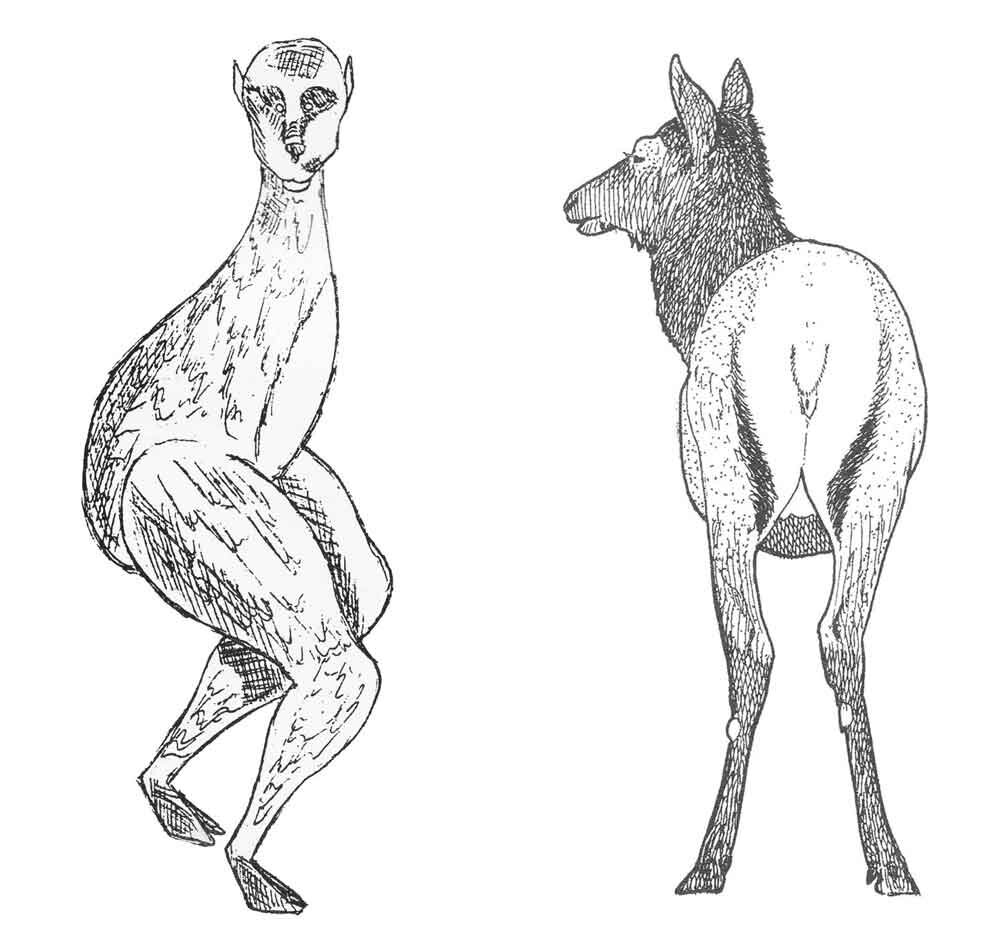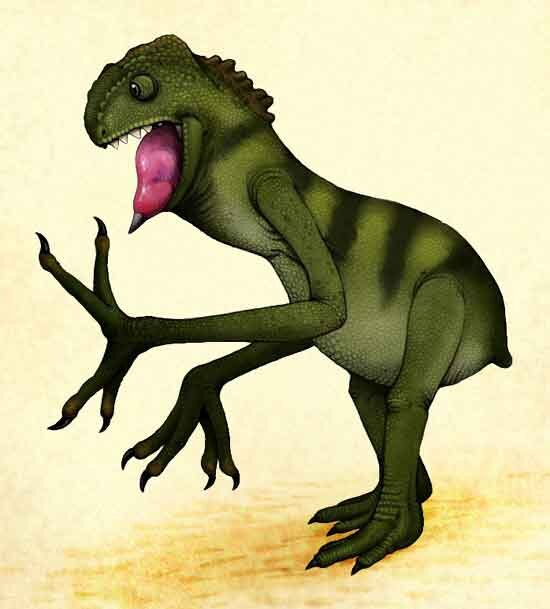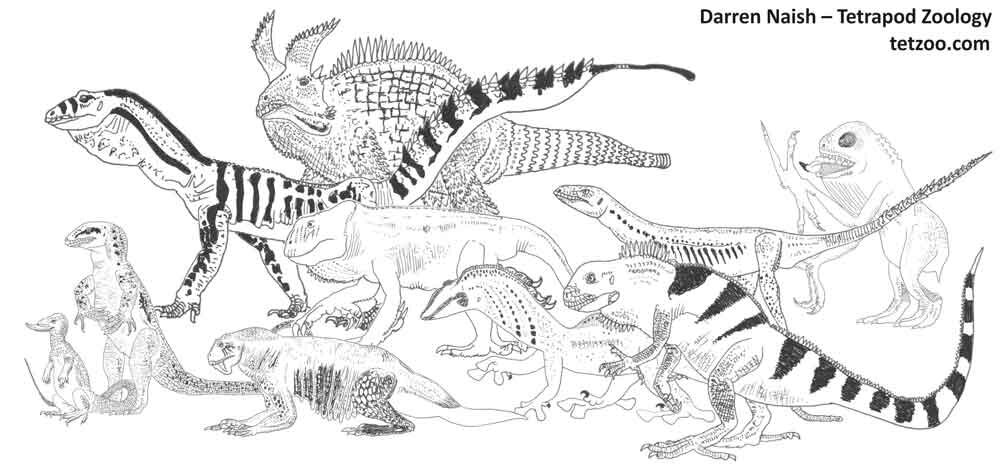At least some of you reading this will know my 2013 book The Cryptozoologicon, produced in collaboration with John Conway and C. M. Kösemen (Conway et al. 2013).
Caption: at left, cover of the 2013 book The Cryptozoologicon. At right, a scene from the book’s interior, depicting yetis in a Himalayan scene; by John Conway. Image: Conway et al. (2013).
The Cryptozoologicon is devoted to cryptids; that is, to mystery animals. After describing a given cryptid and proposing how it might actually be explained (sadly, most cryptids now seem to be sociocultural phenomena or the products of fakery or human error, not valid biological entities; Naish 2017), we go on to indulge in a bit of speculative zoology: that is, a bit of ‘what if’ speculation whereby we imagine ourselves inhabiting a parallel universe where cryptids are real (Conway et al. 2013)…
TetZoo regulars will know that a sequel to The Cryptozoologicon – it’s working title is The Cryptozoologicon Volume 2, duh – has been planned for some time, and we still aim to complete it ‘soon’. Which creatures will be covered in this soon-to-be-published work? I’m not saying, but the article you’re reading now concerns one, just one, of the cryptids we’ve included.
Caption: I really think that some artists have made the Loveland Frog look substantially too frog-like, and this is one of the most extreme examples. But, hey, it’s a nice and technically very competent piece of art. Nice to see Pioneer Dork being used as a scale bar. Image: artist unattributed, Cryptid Wiki (source).
Books on ‘mystery animals’ – cryptids and the like – include a veritable panoply of the weird, unbelievable and ridiculous. Among these, one of my favourites is the Loveland Frog (sometimes called the Loveland Lizard, but that’s just silly): a bipedal, vaguely reptilian animal, similar in size to a child, and supposedly encountered several times in the vicinity of Loveland, Ohio, USA between 1955 and 1972… and there are a few more recent claimed sightings too. The sightings describe greyish, bipedal creatures, said to have a frog-like head, bulging eyes, a leathery, reptile- or amphibian-type skin, and a standing height of between 3 and 4 feet.
The Loveland Frog has been discussed and revisited several times in the mystery animal literature, the tales recounted here having previously been published in Bord & Bord (1989), Newton (2005) and Shuker (2008)*. I especially like Bord & Bord’s (1989) section on the case because it includes the wonderful illustration you see below, produced by Ron Schaffner, and evidently based on a pencil drawing produced by one of the witnesses.
* Confession: I didn’t have Loren Coleman’s Mysterious America to hand while writing, nor W. Haden Blackman’s The Field Guide to North American Monsters. I understand that these works also include coverage of this creature.
Caption: Ron Schaffner’s evocative illustration of the Loveland Frog, very obviously based on the pencil sketch shown below. Note the suggestion of cranial horns, the rows of parasagittal spines and the oval eyes. Image: Ron Schaffner, from Bord & Bord (1989).
Sources that discuss the Loveland Frog most usually recount the observation of police officer Ray Shockey (though spelt Shocke in some sources) who stopped to observe a creature seen crossing the road at 1am on March 3rd 1972, when it was cold enough for the road to be icy. Shockey’s creature was in a crouching position but then stood erect and stared in Shockey’s direction before climbing the guardrail separating the road from the ground that slopes down to the Little Miami River (Newton 2005, Haupt 2015). Other officers later came out to check Shockey’s observations. There’s some talk of them finding scratch marks on the guardrail but efforts to locate photos verifying the presence of said scratches haven’t been successful (Haupt 2015).
Caption: A pencil drawing of the Loveland Frog, I assume that made by Ray Shockey (though I’ve been unable to confirm this; I found it, unattributed, at various sites online and haven’t seen it in print). The artist evidently had quite some skill.
An account similar to Shockey’s was made by another police officer – Mark Matthews – two weeks later, and this again involved the animal being encountered on the road at night and seen from a patrol car. Matthews was concerned as the creature stood up from a crouched stance and fired his gun at it – yee-haw!! ‘Murica!! – and seemingly injured the animal. Again, it climbed out of sight over the guardrail.
Caption: another depiction of Shockey’s frogish encounter, this time showing the creature with a sumptuous butt and disturbingly human-like physique. This image is widely available online but I’ve been unable to find the artist’s name.
But Matthews later claimed that none of this was accurate, that he’d actually seen a big lizard (an escaped pet iguana?), and that he’d augmented the story as a way of making his colleague (Shockey) seem like less of a nut. I really like the deep investigation of this account provided by Ryan Haupt for the Skeptoid Podcast (here; Haupt 2015). It provides lots of additional information and is clearly substantially more reliable than the recountings of events provided in standard cryptozoology- and paranormal-themed websites and publications. Haupt states that there’s what appears to be an email confession from Matthews whereby the account was dismissed as being ‘blown out of proportion’, though its authenticity (it – the ‘confession’ – appears to have originated from this 2001 article from X-Project Paranormal Magazine) is doubtful. An implication that a big lizard might have been seen must also be considered doubtful in view of the icy conditions (and cold temperatures) of the time. A big lizard would be hiding away somewhere, not out and about. Apparently, there’s a sketch that accompanies either Shockey’s or Matthews’s account (Newton 2005; though his text seems to combine both accounts into a single sighting); I assume it’s the pencil one shared above. A local farmer is also said to have seen a Loveland Frog shortly afterwards but details are hazy.
Caption: images showing all three of Hunnicut’s Loveland Frogs together are rare, but at least there’s this fine piece of work by John Meszaros. Image: Cryptids State-by-State, John Meszaros (source).
The oldest Loveland Frog story pre-dates these 70s one and concerns a sighting made on an Ohio roadside during the early morning of May 25th 1955. The story goes that a businessman or travelling salesman – sometimes said to be unknown and sometimes specifically identified as Mr Robert Hunnicut (Newton 2005) – was driving home from work when, at 3.30am, he saw three bipedal, greyish reptilian creatures, each about 3 feet tall. The witness stopped and observed them for a few minutes. In some versions of the story, the creatures were seen ‘conversing’, in some they were observed under a bridge, and in some one of them held a cylindrical or wand-like device above its head. This released sparks and was frightening enough that it inspired the witness to flee.
Post-1972, the Loveland Frog has been rare. There’s a 2016 event in which two teenagers – out playing Pokémon Go, apparently (this isn’t a sexual euphemism) – supposedly saw and even photographed what appears to be the creature. But as you can see for yourself, this event is almost definitely a hoax.
Caption: a still from the 2016 footage taken by Sam Jacobs and his girlfriend. The actual footage is exceedingly dark and this image has been brightened as much as possible (by the people at Fox19 News). Some think that the photo actually shows a lawn decoration with added lightbulbs. Image: Fox19 News (source).
Explaining the Loveland Frog, or trying to. Given the several peculiarities of the 1955 ‘three creatures’ account, it’s not surprising that some authors have sought to identify the Loveland Frog as an alien rather than an unknown denizen of Planet Earth. Assuming that Loveland Frog accounts represent actual observations, an explanation mooted by some authors is that they could be confused descriptions of escaped pet iguanas or monitor lizards (Bord & Bord 1989). This is hard to accept given the bipedal postures that witnesses reported, plus the descriptions don’t recall big lizards at all. At a stretch we might consider that big lizards in fleeting bipedal or erect-standing poses were witnessed, with substantial embellishment and confusion resulting in substantially modified descriptive accounts, but the cold temperatures present during some of the sightings also count against this idea.
Perhaps, some might suppose, these fleeting glimpses of big escaped lizards were inadvertently (or deliberately) combined in the minds of the witnesses with their prior knowledge about the ‘big frog monsters’ already said to inhabit the Miami River region. Such stories go back to the 1950s at least and it should be noted that a similar-sounding entity, the ‘Lizardman’, was reported during the 1970s from South Carolina, New Jersey and Kentucky. In other words, there seems to be lore in the region about such creatures… which might mean that any fleetingly-glimpsed, unidentified weird animal could morph into a monster of this sort in the memories of witnesses.
Caption: this is the very best photo of the South Carolina Lizardman, though sadly I couldn’t find the version with the top hat and cane. Taken by a mysteriously anonymous source.
Also worth noting is that the 1950s were the time when amphibious fish-monster creatures were being depicted on the big screen. The sensational and highly popular Creature from the Black Lagoon premiered in 1954 and could well have inspired people – consciously or not – to think or pretend that they might really encounter ‘frog people’ or ‘lizard people’ of this sort.
Caption: is it really coincidental that the Creature from the Black Lagoon appeared the year prior to the first appearance of the Loveland Frog? Well, probably not. Image: public domain (original here).
One more thing. If we’re going to take seriously the idea that Hunnicut and the other alleged witnesses saw real animals and misidentified them, the possibility that they saw big reptiles has to be considered quite unlikely, as noted above. Deer, standing at the roadside and seen in front view, sometimes look like humanoid bipeds since their bodies, hindlimbs and snouts merge into invisibility. I came up with this idea myself after seeing a scary roadside ‘biped’ with a round body, wide neck and slender legs morph into a deer as the car I was in approached and passed it, and I think that a few very odd sightings of similar creatures (like John Irwin’s Wharton State Forest monster of December 1993; Coleman 1995) could be explained the same way. Could confused observations of this sort explain creatures like the Loveland Frog? It’s worth considering.
Caption: how do we explain (or attempt to explain) ‘monster’ sightings like the creature reported by John Irwin in 1993? Irwin’s drawing (from Coleman 1995) is shown at left. The ‘monster’ here has several deer-like features. Could it be that Irwin saw a foreshortened deer and misinterpreted it as a biped? The deer image at right (a Wapiti female) is from Geist (1999). Images: Coleman (1995), Geist (1999).
It came from the Squamozoic. The existence of metre-tall, bipedal reptile-like creatures has to be regarded as fairly unlikely, especially when those reptile-like creature are seen carrying mechanical devices that emit sparks. The real identity behind the creature is obvious, but only if we admit the reality of parallel universes, time travel, and the ability of some creatures to somehow move between disparate points in space and time.
The Loveland Frog was no giant, humanoid frog at all, but actually a giant, vaguely humanoid lizard, and specifically one of the short-faced, big-brained iguanians from the parallel Earth of the Squamozoic.
Caption: short-faced, tailless, bipedal body forms evolved on a few occasions among the iguanians of the Squamozoic, most famously in the terrameleons (this is a Terrible terrameleon). It’s not a big step from here to time-travelling, intelligent, tool-using iguanians in 20th century Ohio. Image: electriceel.
On Squamozoic Earth, squamates (lizards, snakes and amphisbaenians) evolved to dominate the large-bodied animal fauna of the planet, and heightened intelligence evolved on several occasions. We conclude that the Loveland Frog is one of the intelligent American iguanians, presumably one that comes from a point in time somewhere in the future relative to our own position in the timeline. Whether these intelligent, parallel-universe iguanians have learnt to master time-travel and hence are deliberately travelling to 20th century Ohio as part of an exploratory or invasive mission, or whether they are merely falling inadvertently through some sort of interdimensional window, we cannot know, but perhaps we will in time.
Caption: a large, intelligent iguanian from the Squamozoic surely explains the Loveland Frog (and likely Lizardman and similar cryptids too). Here are but a few of the Squamozoic’s many denizens. Image: Darren Naish.
Our conclusion that some mystery creatures encountered on Earth are actually travellers from parallel dimensions was unashamedly inspired by promotion of the same idea, presented as a serious possibility in some of the mystery animal literature (Keel 1975, Bord & Bord 1980) and clearly not contradicted by our understanding of the way reality works.
Caption: the Bords were surely right, and John Keel was too.
On that note, The Cryptozoologicon Volume 2 will appear one day, we promise.
For previous TetZoo articles on the Cryptozoologicon project and on cryptozoology and mystery creatures in general, see…
Tales from the Cryptozoologicon: the Yeti, August 2013
Tales from the Cryptozoologicon: Megalodon!, August 2013
The Cryptozoologicon (Volume I): here, at last, December 2013
If Bigfoot Were Real, June 2016
Bigfoot’s Genitals: What Do We Know?, August 2018
A Review of Robert L. France’s Disentangled: Ethnozoology and Environmental Explanation of the Gloucester Sea Serpent, November 2019
Refs - -
Bord, J. & Bord, C. 1980. Alien Animals. Granada, London.
Bord, J. & Bord, C. 1989. Modern Mysteries of the World. Guild Publishing, London.
Coleman, L. 1995. Jersey Devil walks again. Fortean Times 83, 49.
Conway, J., Kosemen, C. M. & Naish, D. 2013. Cryptozoologicon Volume I. Irregular Books.
Geist, V. 1999. Deer of the World. Swan Hill Press. Shrewsbury.
Haupt, R. 2015. The Loveland Frog. Skeptoid Podcast. Skeptoid Media, 30 Jun 2015. Web. 11 Jan 2020.
Keel, J. 1975. Strange Creatures from Time & Space. Nevill Spearman, London.

















